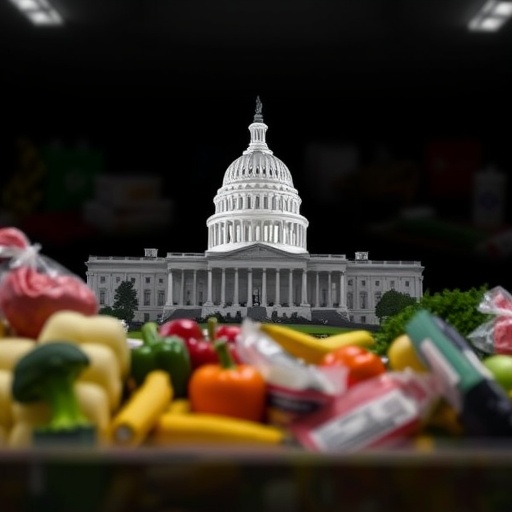In a stark escalation of the ongoing U.S. government shutdown, several states have issued urgent warnings that they could suspend SNAP benefits for millions of low-income families as early as November 1, plunging households into potential food insecurity and intensifying calls for Congress to intervene.
- States Sound Alarm: SNAP Funding Shortfalls Hit Critical Levels
- Families on the Edge: Real Stories from SNAP Recipients
- Congressional Stalemate: Partisan Battles Delay Shutdown Resolution
- Economic Ripples: How SNAP Disruptions Could Unravel Local Economies
- Urgent Pathways Ahead: Bipartisan Push to Safeguard Federal Aid
The Supplemental Nutrition Assistance Program (SNAP), a cornerstone of federal aid that provides vital nutrition support to over 41 million Americans, is now hanging in the balance. As federal funding dries up amid the shutdown—now in its third week—state agencies responsible for administering the program are scrambling to maintain services. Officials in states like California, New York, and Texas have flagged critical shortfalls, estimating that without congressional action, benefits could halt, leaving families without the means to purchase groceries during what many call the ‘hunger cliff.’
This crisis unfolds against a backdrop of partisan deadlock in Washington, where disagreements over spending bills and border security have prolonged the shutdown. The pressure is mounting, with advocacy groups and economists warning of widespread economic fallout if SNAP—the nation’s largest anti-hunger program—is disrupted.
States Sound Alarm: SNAP Funding Shortfalls Hit Critical Levels
State governments, which handle the day-to-day distribution of SNAP benefits through electronic benefit transfer (EBT) cards, are bearing the brunt of the federal shutdown. In California, the nation’s most populous state and home to nearly 5 million SNAP recipients, the Department of Social Services issued a stark advisory on October 25. ‘Without immediate federal reimbursement, we anticipate exhausting our contingency funds by November 1,’ said agency spokesperson Maria Gonzalez. This would affect an estimated 4.8 million individuals, including 2 million children, who rely on SNAP for about $3 billion in monthly benefits.
New York is in a similar bind. Governor Kathy Hochul’s office reported that the state has already dipped into emergency reserves to cover October’s payouts, but projections show a $1.2 billion gap for November. ‘SNAP is not just aid; it’s a lifeline for working families, seniors, and veterans,’ Hochul stated in a press release. ‘The shutdown’s impact will be felt hardest in urban centers like New York City, where food pantries are already overwhelmed.’
Texas, with its sprawling rural and urban populations, faces one of the most acute threats. The Texas Health and Human Services Commission warned that 3.5 million enrollees could see benefits frozen, potentially leading to a surge in emergency food assistance demands. State data indicates that SNAP prevents over 1 million Texans from falling into poverty annually, underscoring the program’s role in stabilizing communities.
These warnings aren’t isolated. A coalition of 15 states, including Florida, Illinois, and Pennsylvania, sent a joint letter to Congress on October 28, pleading for an extension of federal funding. The letter highlighted that administrative costs alone—borne by states during shutdowns—could exceed $500 million nationwide by mid-November. Without intervention, EBT systems might grind to a halt, forcing families to seek alternatives like soup kitchens or high-interest loans for food.
- Key Statistics: SNAP serves 12% of the U.S. population, with benefits averaging $250 per person monthly.
- During past shutdowns, like in 2013, states averted total cutoffs through borrowing, but current debt levels make this untenable.
- Women and children comprise 60% of SNAP households, amplifying the human stakes.
Experts note that while short-term waivers exist for some federal programs, SNAP’s scale—totaling $113 billion in fiscal year 2023—makes it uniquely vulnerable. ‘The shutdown is exposing the fragility of our federal aid infrastructure,’ said Dr. Elena Ramirez, a policy analyst at the Center on Budget and Policy Priorities. ‘States can’t shoulder this indefinitely.’
Families on the Edge: Real Stories from SNAP Recipients
Behind the numbers are harrowing personal narratives that illustrate the shutdown’s human toll. In Los Angeles, single mother Carla Jenkins, 34, depends on SNAP to feed her two young children. ‘I’ve budgeted every penny for groceries, but if benefits stop on November 1, we’ll be out of options,’ Jenkins shared in an interview. Working two part-time jobs as a cashier, she supplements her $1,200 monthly income with $400 in SNAP aid, which covers essentials like milk, bread, and fresh produce.
Jenkins isn’t alone. Across the country, SNAP has been a buffer against rising food prices, which have surged 25% since 2020 according to the U.S. Department of Agriculture (USDA). In rural Ohio, veteran Mark Thompson, 62, relies on benefits to manage his fixed income after a service-related injury. ‘Congress needs to see this isn’t politics—it’s survival,’ Thompson said. His local food bank reported a 40% increase in demand last week, as rumors of SNAP disruptions spread.
In Chicago, immigrant families are particularly hard-hit. Maria Lopez, a community organizer with the Illinois Coalition Against Hunger, recounted stories of families skipping meals to preserve benefits. ‘We’ve seen a spike in calls to our hotline—up 150% since the shutdown began,’ Lopez explained. One caller, a father of three, confessed to rationing cereal for his kids, fearing the worst if federal aid ceases.
These anecdotes align with broader data from Feeding America, which estimates that a one-month SNAP interruption could push 8 million more Americans into food insecurity. Children, who make up 40% of recipients, face long-term risks like developmental delays from malnutrition. ‘Hunger doesn’t wait for Congress to compromise,’ Lopez emphasized. Advocacy groups are mobilizing, with petitions garnering over 500,000 signatures urging lawmakers to prioritize SNAP in any shutdown resolution.
The emotional resonance is clear: SNAP isn’t welfare in the pejorative sense but a targeted intervention that lifts 8 million people out of poverty yearly, per USDA reports. As the deadline looms, families like Jenkins’ are stockpiling non-perishables, but experts warn this is no substitute for sustainable federal support.
Congressional Stalemate: Partisan Battles Delay Shutdown Resolution
At the heart of the crisis is a deepening divide in Congress, where Republicans and Democrats remain locked in negotiations over a continuing resolution (CR) to fund the government. The shutdown, triggered by expired appropriations on October 1, stems from disputes over $20 billion in additional border security funding demanded by House Republicans. Speaker Mike Johnson has tied the CR to these measures, while Senate Democrats, led by Majority Leader Chuck Schumer, insist on a ‘clean’ bill without policy riders.
‘This impasse is putting millions at risk for the sake of political posturing,’ said Sen. Elizabeth Warren (D-MA) during a floor speech on October 27. She highlighted SNAP’s bipartisan history, noting that the program was expanded under both parties, including during the Trump administration’s farm bills. On the Republican side, Rep. Tom Emmer (R-MN) argued that fiscal responsibility demands reforms to SNAP, such as work requirements, but acknowledged the urgency: ‘No one wants families going hungry, but we can’t ignore the deficit.’
Negotiations have yielded little progress. A White House briefing on October 29 revealed that President Biden has vetoed two proposed CRs, calling them ‘extremist.’ Meanwhile, the Congressional Budget Office projects that a prolonged shutdown could cost the economy $6 billion weekly, with SNAP disruptions adding $2 billion in indirect losses from reduced consumer spending.
Lobbying efforts are intensifying. The National Association of State SNAP Directors met with key lawmakers on Capitol Hill, presenting data showing that every day of delay costs states $100 million in unreimbursed expenses. Bipartisan voices, like Sen. Susan Collins (R-ME), are pushing for a short-term funding bridge to avert the November 1 cliff. ‘SNAP benefits are non-negotiable; let’s fund them now and debate reforms later,’ Collins urged.
Historical precedents loom large. The 2018-2019 shutdown, the longest on record at 35 days, briefly threatened SNAP before a last-minute deal. This time, with midterm elections approaching, political incentives may finally align—but not without further strain on federal aid systems.
Economic Ripples: How SNAP Disruptions Could Unravel Local Economies
Beyond immediate hunger risks, the potential SNAP suspension threatens broader economic stability. As a significant driver of local commerce, SNAP injects $1.50 into the economy for every dollar spent, according to a USDA study. In states like California and New York, where grocers and farmers markets depend on EBT transactions, a cutoff could lead to immediate revenue drops of 20-30%.
Small businesses are voicing alarm. In Texas, the Texas Grocers Association estimated that a month’s SNAP halt could result in $2.5 billion in lost sales, potentially forcing layoffs in an already tight labor market. ‘Our members serve SNAP shoppers exclusively in food deserts; this shutdown hits them hardest,’ said association president Laura Martinez.
Nationally, the ripple effects extend to agriculture. SNAP boosts demand for U.S.-grown produce, supporting 400,000 farm jobs. A report from the American Farm Bureau Federation warns that reduced benefits could depress commodity prices, exacerbating challenges for Midwest farmers still recovering from droughts.
Economists like Mark Zandi of Moody’s Analytics predict a 0.5% GDP hit if the shutdown extends into November, with SNAP’s role in poverty alleviation amplifying the damage. Low-income spending on food sustains retail and supply chains; disruptions could trigger a domino effect, increasing reliance on costlier safety nets like unemployment benefits.
- Short-Term Impacts: Surge in food bank usage, projected to rise 50% in affected states.
- Long-Term Consequences: Increased healthcare costs from nutrition-related illnesses, estimated at $10 billion annually.
- Policy Lessons: Calls for SNAP modernization, including digital upgrades to withstand future shutdowns.
The shutdown also intersects with inflation concerns. With food costs up 11% year-over-year, SNAP’s erosion could widen inequality, pushing more families toward debt. Business leaders, including Walmart CEO Doug McMillon, have lobbied Congress, noting that 18% of the retailer’s sales come from SNAP users.
Urgent Pathways Ahead: Bipartisan Push to Safeguard Federal Aid
As November 1 approaches, the window for action narrows, but glimmers of hope emerge. House Minority Leader Hakeem Jeffries (D-NY) announced on October 30 that a bipartisan working group is drafting a CR with SNAP protections, potentially passing by week’s end. This includes $15 billion in emergency federal aid to bridge state shortfalls, alongside phased border funding.
Advocacy is ramping up. The U.S. Conference of Mayors has declared a ‘hunger emergency’ in 50 cities, urging mayoral interventions like local food vouchers. Nonprofits like No Kid Hungry are prepping contingency plans, including mobile pantries, but stress that only Congress can restore full SNAP functionality.
Looking forward, experts advocate for structural reforms. Proposals include a ‘shutdown-proof’ SNAP fund, pre-allocated at $50 billion, to insulate benefits from fiscal disputes. Bipartisan bills like the SNAP Stability Act, reintroduced last year, aim to codify such measures. ‘We’ve learned from past shutdowns; now’s the time to act decisively,’ said Rep. Angie Craig (D-MN), a co-sponsor.
If resolved swiftly, the crisis could bolster public support for modernizing federal aid, ensuring SNAP’s resilience against future political storms. For the millions awaiting their next EBT reload, the stakes remain profoundly personal: stability, health, and hope hinge on Congress’s next move. As negotiations intensify, the nation watches, knowing that delay exacts a steep human price.










